One of the seven wonders of the ancient world, the Lighthouse of Alexandria towered over the port of Alexandria, Egypt for centuries — but it’s sadly in ruins today.
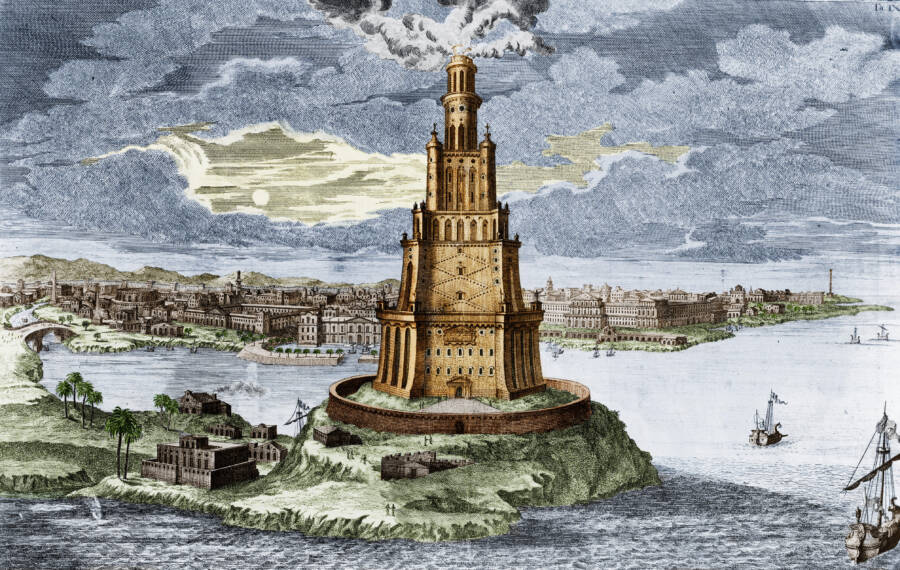
Science History Images / Alamy Stock PhotoA depiction of the Lighthouse of Alexandria, one of the Seven Wonders of the Ancient World.
In Alexandria, Egypt, there once stood the Lighthouse of Alexandria, one of the Seven Wonders of the Ancient World. At the time of its construction, it was heralded as a triumph of technology, towering more than 300 feet tall on the island of Pharos in the city’s harbor.
Nearly every lighthouse since its inception has used the Lighthouse of Alexandria’s design as a point of reference, which means that this famous lighthouse cast a large shadow in more ways than one.
Yet despite its prominence in the ancient world, the Lighthouse of Alexandria suffered its fair share of misfortune and natural disasters. The grand structure eventually fell into ruin — but its story doesn’t stop there.
Building The Lighthouse Of Alexandria
The idea for the Lighthouse of Alexandria came at the dawn of the third century B.C.E., just as Ptolemy — a Greek general who served under Alexander the Great — declared himself pharaoh.

British MuseumPtolemy I, who founded the Ptolemaic Kingdom upon the death of Alexander the Great.
Likely built by Sostratus of Cnidus (though he may have simply been a financial backer of the project), the lighthouse was constructed on the island of Pharos in Alexandria’s harbor. There, it was meant to guide ships to shore and help captains avoid shipwrecks at night. (To this day, the word for “lighthouse” in many Romance languages descends from the “Pharos”.)
Though estimates vary, the lighthouse took at least a decade — and perhaps as many as three — to complete. It wasn’t finished until the reign of Ptolemy II, who ruled from 284 to 246 B.C.E.
Upon completion, the Lighthouse of Alexandria towered more than 300 feet over the harbor (estimates of its exact height vary) and was one of the tallest man made structures on Earth. It’s height was purportedly increased by the statue at its top, which may have depicted Ptolemy, Alexander the Great, or a Greek god. Only the Pyramids of Giza got closer to touching the sky.
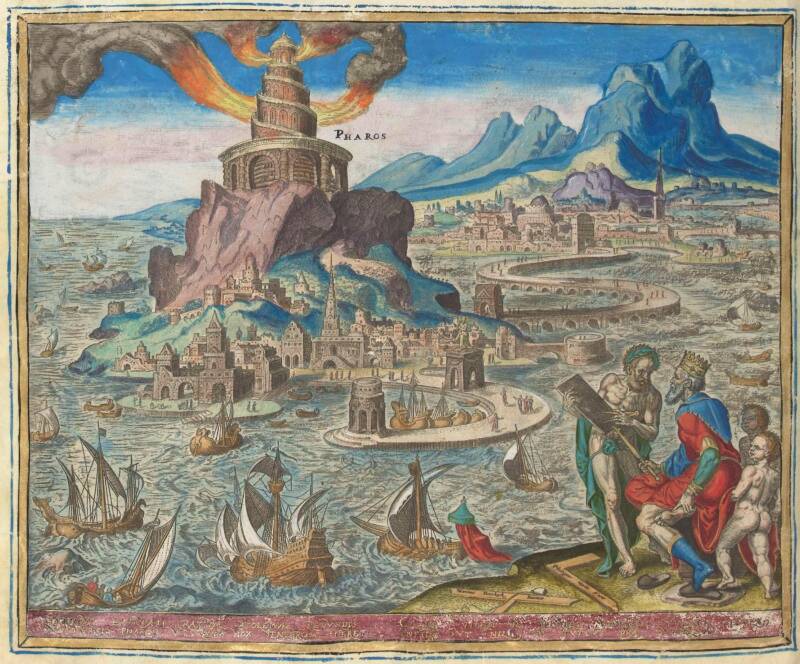
Wikimedia CommonsA painting depicting the Lighthouse of Alexandria.
The lighthouse certainly added to the rich vitality of Alexandria, which also contained the tomb of Alexander the Great, the Museum of Alexandria (a classical center of learning), the Serapeum temple, and the Library of Alexandria, brimming with wealth of knowledge about the ancient world.
More than that, the Lighthouse of Alexandria was an architectural marvel, now known as one of the Seven Wonders of the Ancient World alongside the likes of the Mausoleum at Halicarnassus.
The Famous Structure’s Intricate Design
Most of what is known about the Lighthouse of Alexandria’s structure comes from the 20th century German classical archaeologist Hermann Thiersch, particularly his 1909 work Pharos, antike, Islam und Occident, in which he describes how the lighthouse was built in three stages.
The lowest stage of the lighthouse, according to Thiersch’s translations of ancient texts, was square. The second stage was an octagon. And the third, top stage was a cylinder. Each of these stages sloped slightly inward, and a spiral ramp went around the outside, leading up to the fire which perpetually burned at the very top of the lighthouse.
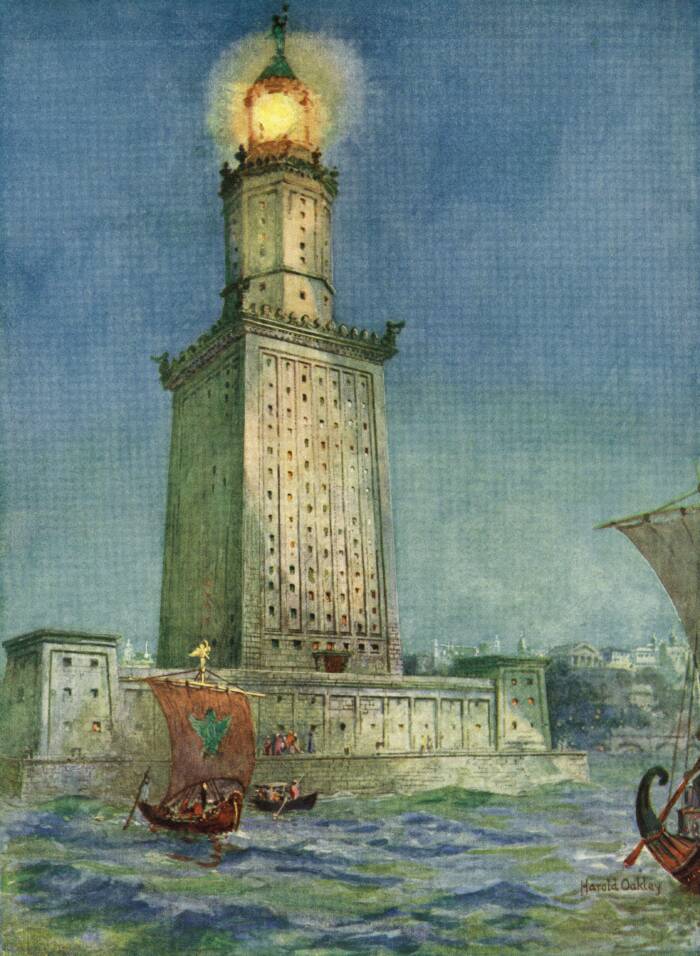
Classic Image / Alamy Stock PhotoThe lighthouse’s fire helped ships see it at night, and its billowing smoke helped with visibility during the day.
In addition to a fire which burned at the tip of the structure at night, it was also equipped with a mirror, likely made of bronze, to project its flame out to sea. This made the lighthouse visible to ships from 30 miles away.
Over the years, the lighthouse sustained repeated damage from earthquakes and required repairs, but descriptions of it remain largely consistent. It was constructed of light-colored stone, and the side of the lighthouse which faced the sea contained an inscription dedicated to the god Zeus, whose statue at Olympia represents another one of the Seven Wonders of the Ancient World.
That is, until it slowly tumbled into the sea.
The Demise Of The Lighthouse Of Alexandria
Massive earthquakes between 796 and 956 C.E. caused significant damage to the lighthouse, causing it to crack in several places. These also caused damage to the top 60 or so feet of the lighthouse.
These quakes were followed by more devastating natural disasters several centuries later. Earthquakes and tsunamis in 1303 and 1323 destroyed much of the structure and reduced it to nothing more than a small ruin.
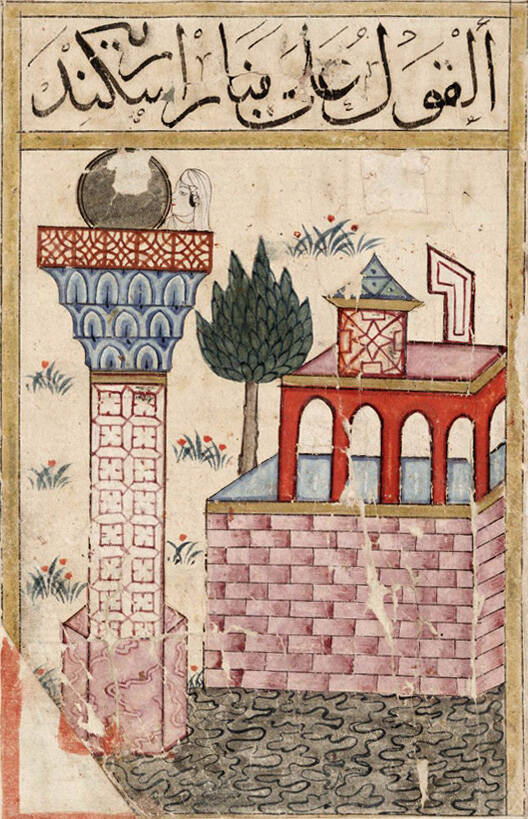
Wikimedia CommonsThe Lighthouse of Alexandria as it appears in the Book of Wonders.
In 1480, the Sultan of Egypt built a fort within the lighthouse’s ruins, effectively putting the final nail in the Lighthouse of Alexandria’s coffin.
Although historical records of the lighthouse remained — it first appeared on a list of world wonders in the 6th century C.E., and it was still standing in pieces by the 12th century — the Lighthouse of Alexandria seemed lost to time until the 20th century. Then, archaeologists made a stunning discovery.
The Rediscovery Of A Lost World Wonder
In 1916, the archaeologist Gaston Jondet discovered submerged ruins within the old port of Alexandria. He wrote a detailed description of the ruins, but unfortunately lacked the archaeological evidence to accurately date them. Those ruins were observed by Raymond Weill that same year, and then by Sir Leopold Halliday Savile in 1940.
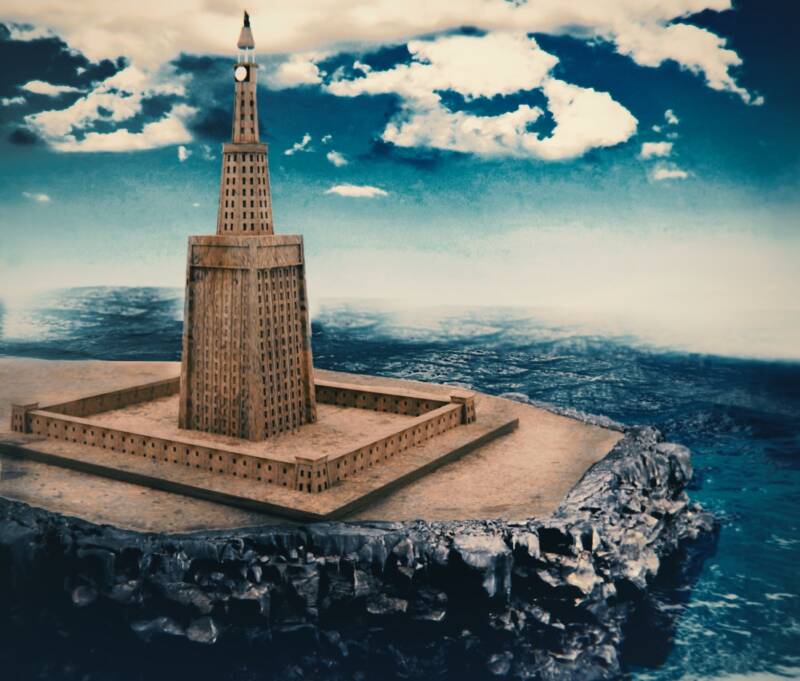
Wikimedia CommonsA 3D render of the Lighthouse of Alexandria.
By this point, it was clear that something was in the waters off of Alexandria, but it wasn’t clear what, exactly, it was.
Then, in 1968, UNESCO sponsored an archaeological expedition in the old port of Alexandria led by Honor Frost, a leader in the field of marine archaeology. During this expedition, Frost reaffirmed Jondet’s original discovery and even claimed that the ruins did indeed belong to the long lost Lighthouse of Alexandria.
Unfortunately, research had to be put on hold, as the region was being occupied for military purposes.
It wasn’t until 1994 that archaeologist Jean-Yves Empereur, who founded the Center for Alexandrian studies, re-discovered the actual, physical remains of the lighthouse in the waters off Pharos Island.
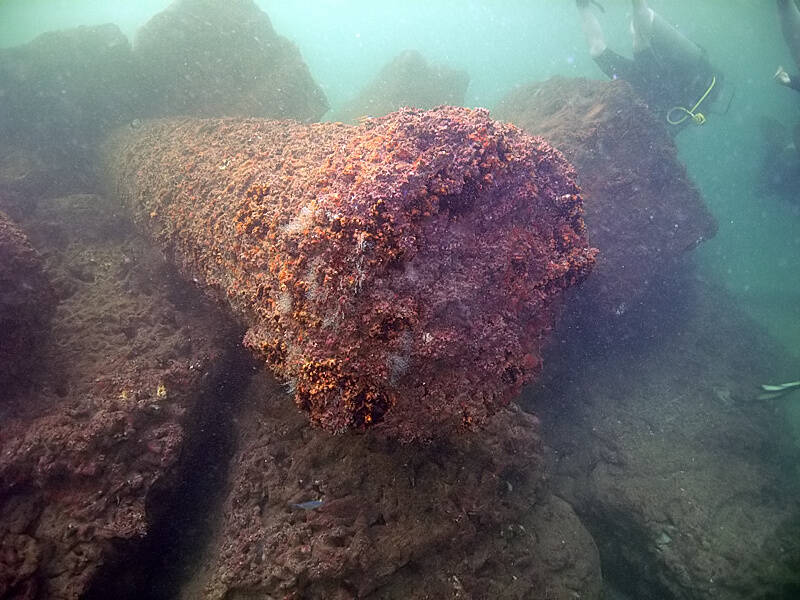
Wikimedia CommonsRemains of the Lighthouse of Alexandria discovered off the coast of Pharos.
The Egyptian government had contracted Empereur to map and catalog anything that held archaeological significance off the Pharos coast as it prepared to construct a concrete breakwater over the site. During this process, Empereur and cinematographer Asma el-Bakri, using a 35mm camera, captured the first underwater images of the lighthouse’s remains.
Empereur and his team recovered numerous pieces of the old lighthouse, including, according to Smithsonian Magazine, massive blocks of granite, 30 sphinxes, five obelisks, and various columns with inscriptions dating back to the time of Ramses II.
In all, Empereur and his team cataloged more than 3,300 pieces of the lighthouse by the end of 1995, some of which are still on display at museums in Alexandria. The Lighthouse of Alexandria, the formidable beacon of the ancient world, had been given a second life.
And since then, increasingly advanced technology has revealed more of ancient Alexandria, including wharves, houses, and temples, all of which had fallen into the ocean due to natural disasters.
“We supposed old Alexandria was destroyed,” Empereur has remarked, “only to realize that when you walk on the sidewalks, it is just below your feet.”
After learning all about the Lighthouse of Alexandria, discover more about the Seven Wonders of the Ancient World, including the Hanging Gardens of Babylon and the Colossus of Rhodes. Then, learn about the New Seven Wonders of the World.





